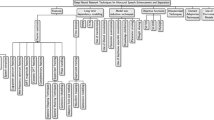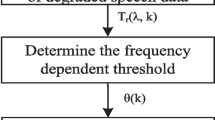Abstract
In modern telecommunication systems the presence of noise in background degrades the overall intelligibility and quality of the speech signal. The problem of enhancing speech signals and reducing acoustic noise from the noisy environment using adaptive filtering algorithms with incorporation of blind source separation approach has drawn a particular attention in the recent past. In this paper a dual channel double backward distributive weighted adaptive filtering algorithm is proposed for speech quality enhancement. The proposed method has been evaluated using the objective measures such as Perceptual Evaluation of Speech Quality (PESQ) and Short Time Objective Intelligibility (STOI) in different noise setup and the results achieved indicate that this is a better method for speech quality improvement.






Similar content being viewed by others
References
Adam, E. E. B. (2020). Deep learning based NLP techniques in text to speech synthesis for communication recognition. Journal of Soft Computing Paradigm (JSCP), 2(04), 209–215.
Al-Kindi, M. J., & Dunlop, J. (1989). Improved adaptive noise cancellation in the presence of signal leakage on the noise reference channel. Signal Processing, 17(3), 241–250.
Bashar, A. (2019). Survey on evolving deep learning neural network architectures. Journal of Artificial Intelligence, 1(02), 73–82.
Benallal, A., & Arezki, M. (2014). A fast convergence normalized least-mean-square type algorithm for adaptive filtering. International Journal of Adaptive Control and Signal Processing, 28(10), 1073–1080.
Bendoumia, R., & Djendi, M. (2015). Two-channel variable-step-size forward and backward adaptive algorithms for acoustic noise reduction and speech enhancement. Signal Processing, 108, 226–244.
Cioffi, J., & Kailath, T. (1984). Fast recursive least squares transversal filters for adaptive filtering. IEEE Transactions on Acoustic Speech Signal Processing ASSP, 32, 304–337.
Djendi, M., Henni, R., & Sayoud, A. (2016). A new dual forward BSS based RLS algorithm for speech enhancement. In International Conference on Engineering and MIS, ICEMIS 2016, Agadir, Morooco.
Djendi, M., & Bendoumia, R. (2013). A new adaptive filtering subband algorithm for two-channel acoustic noise reduction and speech enhancement. Computers & Electrical Engineering, 39(8), 2531–2550.
Djendi, M., & Bendoumia, R. (2014). A new efficient two-channel backward algorithm for speech intelligibility enhancement: A subband approach. Applied Acoustics, 76, 209–222.
Djendi, M., Gilloire, A., & Scalart, P. (2007). New frequency domain post-filters for noise cancellation using two closely spaced microphones. Proc EUSIPCO, Poznan, 1, 218–221.
Gerven, S. V., & Compernolle, D. V. (1995). Signal separation by symmetric adaptive decorrelation: Stability, convergence, and uniqueness. IEEE Transactions on Signal Processing, 43(7), 1602–1612.
Ghribi, K., Djendi, M., & Berkani, D. (2016). A New wavelet-based forward BSS algorithm for acoustic noise reduction and speech quality enhancement. Applied Acoustics, 105, 55–66.
Kajla, P., & George, N. V. (2020). Speech quality enhancement using a two channel sparse adaptive filtering approach. Applied Acoustics, 158, 107035.
Manoharan, S. (2019). A smart image processing algorithm for text recognition information extraction and vocalization for the visually challenged. Journal of Innovative Image Processing (JIIP), 1(01), 31–38.
Mirchandani, G., Zinser, R. L., & Evans, J. B. (1992). A new adaptive noise cancellation scheme in the presence of crosstalk. IEEE Transactions on Circuits and Systems, 39(10), 681–694.
Mitra, A. (2020). Sentiment analysis using machine learning approaches (Lexicon based on movie review dataset). Journal of Ubiquitous Computing and Communication Technologies (UCCT), 2(03), 145–152.
Nicolas, D., & Mike, B. (2019). Modulation domain kalman filtering for monaural blind speech denoising and dereverberation. IEEE/ACM Transactions on Audio, Speech and Language Processing, 27(4), 799–814.
Ozeki, K., & Umeda, T. (1984). An adaptive filtering algorithm using an orthogonal projection to an affine subspace and its properties. Electronics and Communications in Japan, 67(5), 19–27.
Rahima, H., Mohamed, D., & Djebari, M. (2018). A dual backward adaptive algorithm for speech enhancement and acoustic noise reduction. In Proceedings of the Fourth International Conference on Engineering & MIS 2018 (pp. 1–4).
Raj, J. S. (2019). A comprehensive survey on the computational intelligence techniques and its applications. Journal of ISMAC, 1(03), 147–159.
Rakesh, P., & Kumar, T. K. (2015). A novel RLS adaptive filtering method for speech enhancement. Electrical, Computer, Energetic, 9(2), 225–229.
Rix, A. W., Beerends, J. G., Hollier, M. P., & Hekstra, A. P. (2001). Perceptual evaluation of speech quality (PESQ)-a new method for speech quality assessment of telephone networks and codecs. In 2001 IEEE international conference on acoustics, speech, and signal processing. Proceedings (Cat. No. 01CH37221) (Vol. 2, pp. 749-752). IEEE
Sayoud, A., Djendi, M., Medahi, S., & Guessoum, A. (2018). A dual fast nlms adaptive filtering algorithm for blind speech quality enhancement. Applied Acoustics, 135, 101–110.
Shrawankar, U., & Thakare, V. (2010). Noise estimation and noise removal techniques for speech recognition in adverse environment. In International Conference on Intelligent Information Processing (pp. 336–342). Springer, Berlin,
Taal, C. H., Hendriks, R. C., Heusdens, R., & Jensen, J. (2010). A short-time objective intelligibility measure for time-frequency weighted noisy speech. In 2010 IEEE international conference on acoustics, speech and signal processing (pp. 4214–4217).
Widrow, B., & Hoff, M. (1960). Adaptive switching circuits. In Proceedings of IRE Western Electronic Show and Convention (Part 4, pp. 96–104).
Author information
Authors and Affiliations
Corresponding author
Additional information
Publisher's Note
Springer Nature remains neutral with regard to jurisdictional claims in published maps and institutional affiliations.
Rights and permissions
About this article
Cite this article
Srinivasarao, V., Ghanekar, U. A new double backward distributive weighted adaptive filtering approach for speech quality improvement. Int J Speech Technol 25, 831–836 (2022). https://doi.org/10.1007/s10772-021-09894-0
Received:
Accepted:
Published:
Issue Date:
DOI: https://doi.org/10.1007/s10772-021-09894-0




